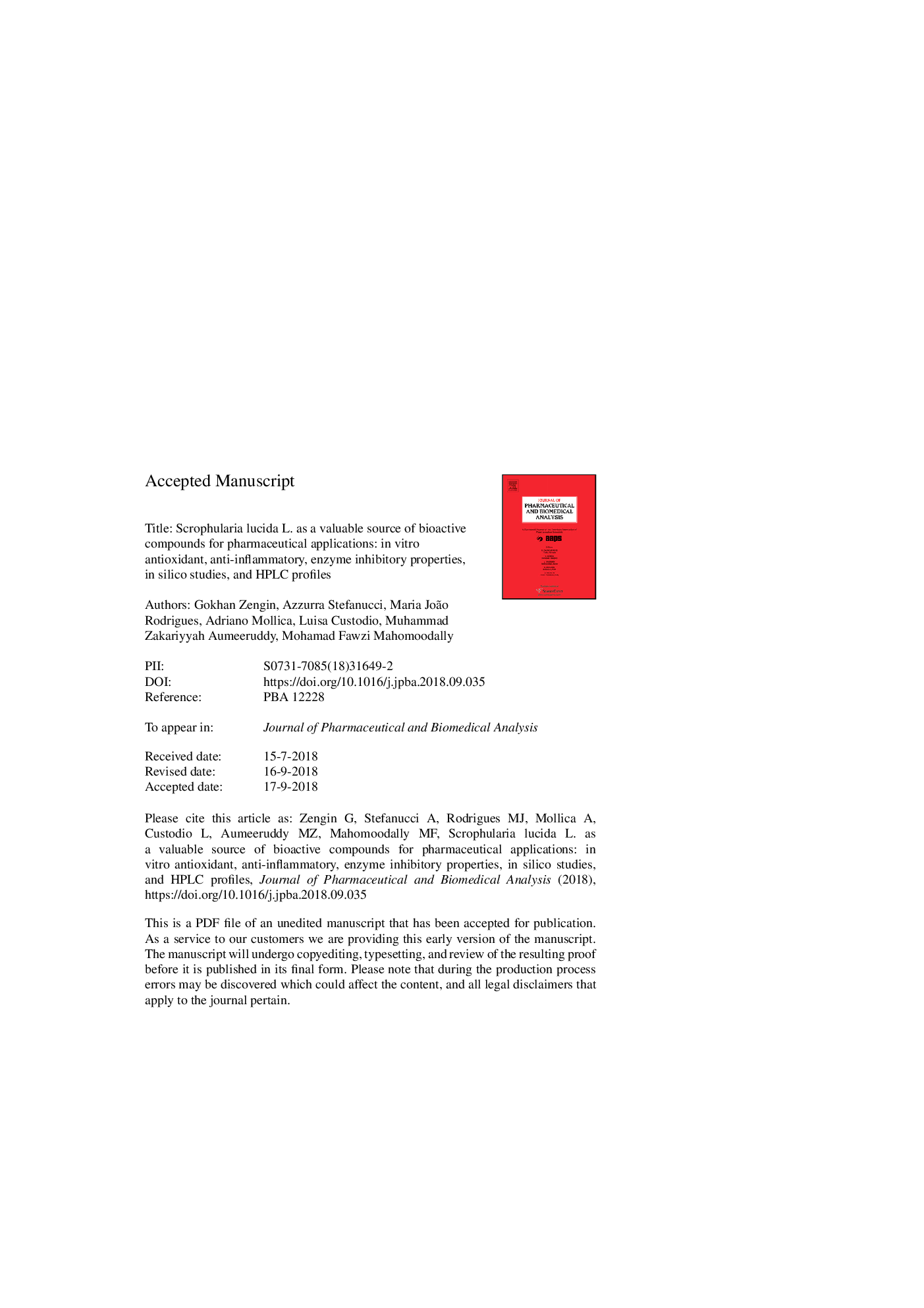| کد مقاله | کد نشریه | سال انتشار | مقاله انگلیسی | نسخه تمام متن |
|---|---|---|---|---|
| 11027366 | 1666301 | 2019 | 32 صفحه PDF | دانلود رایگان |
عنوان انگلیسی مقاله ISI
Scrophularia lucida L. as a valuable source of bioactive compounds for pharmaceutical applications: In vitro antioxidant, anti-inflammatory, enzyme inhibitory properties, in silico studies, and HPLC profiles
دانلود مقاله + سفارش ترجمه
دانلود مقاله ISI انگلیسی
رایگان برای ایرانیان
کلمات کلیدی
DPPHKAEBChEbutyrylcholinesteraseGAETFCCUPRACTPCFRAPABTS1,1-diphenyl-2-picrylhydrazyl - 1،1-دیفنیل-2-پریکیل هیدرازیلAntioxidant - آنتی اکسیدانAChE - آهیAcetylcholinesterase - استیل کولین استرازTyrosinase - تیروزیناز Docking - داکتrutin equivalents - روتین معادلAnti-inflammatory - ضدالتهابcupric reducing antioxidant capacity - ظرفیت آنتی اکسیدان را کاهش می دهدPhenolic - فنولیTotal phenolic content - محتوای فنلی کلGallic acid equivalent - معادل اسید گالیکtrolox equivalent - معادل ترولوکسTotal flavonoid content - مقدار کل فلاونوئیدferric reducing antioxidant power - کاهش قدرت آنتی اکسیدان آهن
موضوعات مرتبط
مهندسی و علوم پایه
شیمی
شیمی آنالیزی یا شیمی تجزیه
پیش نمایش صفحه اول مقاله

چکیده انگلیسی
The genus Scrophularia has received much interest with regards to its traditional uses against eczema, psoriasis, and mastitis. Yet, the medicinal properties of some species still need to be scientifically validated. The present study was designed to investigate into the biological properties of various solvent extracts (ethyl acetate, methanol, and aqueous) of the roots and aerial parts of Scrophularia lucida based on its antioxidant, anti-inflammatory, and enzyme inhibitory activities together with phytochemical screening. Our results revealed that the solvent extracts differed in their biological effectiveness. The root ethyl acetate extract showed the highest ABTS scavenging, FRAP, CUPRAC, and inhibitory activity against AChE and α-glucosidase. The ethyl acetate extract of the aerial parts displayed the highest BChE and α-amylase inhibition and antioxidant effect in the phosphomolybdenum assay, while the methanol extracts of both parts were the most effective DPPH
- scavengers and tyrosinase inhibitors. The methanol extracts of the root and aerial parts also inhibited NO production in lipopolysaccharide (LPS)-stimulated murine leukemic monocyte-macrophage cell (4.99% and 10.77%, respectively), at 31.25âμg/mL concentration. The highest TPC (34.98âmg GAE/g extract) and TFC (48.33âmg RE/g extract) were observed in the ethyl acetate extract of the root and aerial parts, respectively. The most abundant compounds in the root ethyl acetate extract were luteolin (852âμg/g extract), rosmarinic acid (522âμg/g extract), and hesperidin (394âμg/g extract) while kaempferol was most abundant in the ethyl acetate extract of the aerial parts (628âμg/g extract). In silico experiments were conducted on tyrosinase and the higher docking values were observed for rosmarinic acid and hesperidin. The present findings provide base line information which tend to support the potential use of S. lucida in the management of several chronic diseases, including Alzheimer's disease and diabetes mellitus.
- scavengers and tyrosinase inhibitors. The methanol extracts of the root and aerial parts also inhibited NO production in lipopolysaccharide (LPS)-stimulated murine leukemic monocyte-macrophage cell (4.99% and 10.77%, respectively), at 31.25âμg/mL concentration. The highest TPC (34.98âmg GAE/g extract) and TFC (48.33âmg RE/g extract) were observed in the ethyl acetate extract of the root and aerial parts, respectively. The most abundant compounds in the root ethyl acetate extract were luteolin (852âμg/g extract), rosmarinic acid (522âμg/g extract), and hesperidin (394âμg/g extract) while kaempferol was most abundant in the ethyl acetate extract of the aerial parts (628âμg/g extract). In silico experiments were conducted on tyrosinase and the higher docking values were observed for rosmarinic acid and hesperidin. The present findings provide base line information which tend to support the potential use of S. lucida in the management of several chronic diseases, including Alzheimer's disease and diabetes mellitus.
ناشر
Database: Elsevier - ScienceDirect (ساینس دایرکت)
Journal: Journal of Pharmaceutical and Biomedical Analysis - Volume 162, 5 January 2019, Pages 225-233
Journal: Journal of Pharmaceutical and Biomedical Analysis - Volume 162, 5 January 2019, Pages 225-233
نویسندگان
Gokhan Zengin, Azzurra Stefanucci, Maria João Rodrigues, Adriano Mollica, Luisa Custodio, Muhammad Zakariyyah Aumeeruddy, Mohamad Fawzi Mahomoodally,